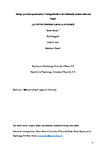'Seeing' proximal representations: Testing attitudes to the relationship between vision and images.
| dc.contributor.author | Samuel, Steven | |
| dc.contributor.author | Hagspiel, K | |
| dc.contributor.author | Cole, G | |
| dc.contributor.author | Eacott, M | |
| dc.date.accessioned | 2021-08-13T09:18:37Z | |
| dc.date.issued | 2021-08-20 | |
| dc.identifier.issn | 1932-6203 | |
| dc.identifier.issn | 1932-6203 | |
| dc.identifier.other | e0256658 | |
| dc.identifier.uri | http://hdl.handle.net/10026.1/17576 | |
| dc.description.abstract |
Corrections applied by the visual system, like size constancy, provide us with a coherent and stable perspective from ever-changing retinal images. In the present experiment we investigated how willing adults are to examine their own vision as if it were an uncorrected 2D image, much like a photograph. We showed adult participants two lines on a wall, both of which were the same length but one was closer to the participant and hence appeared visually longer. Despite the instruction to base their judgements on appearance specifically, approximately half of the participants judged the lines to appear the same. When they took a photo of the lines and were asked how long they appeared in the image their responses shifted; now the closer line appeared longer. However, when they were asked again about their own view they reverted to their original response. These results suggest that many adults are resistant to imagining their own vision as if it were a flat image. We also place these results within the context of recent views on visual perspective-taking | |
| dc.format.extent | e0256658-e0256658 | |
| dc.format.medium | Electronic-eCollection | |
| dc.language | en | |
| dc.language.iso | en | |
| dc.publisher | Public Library of Science | |
| dc.subject | Adult | |
| dc.subject | Humans | |
| dc.subject | Judgment | |
| dc.subject | Psychological Tests | |
| dc.subject | Vision, Ocular | |
| dc.title | 'Seeing' proximal representations: Testing attitudes to the relationship between vision and images. | |
| dc.type | journal-article | |
| dc.type | Journal Article | |
| plymouth.author-url | https://www.webofscience.com/api/gateway?GWVersion=2&SrcApp=PARTNER_APP&SrcAuth=LinksAMR&KeyUT=WOS:000686828600043&DestLinkType=FullRecord&DestApp=ALL_WOS&UsrCustomerID=11bb513d99f797142bcfeffcc58ea008 | |
| plymouth.issue | 8 | |
| plymouth.volume | 16 | |
| plymouth.publication-status | Published online | |
| plymouth.journal | PLoS One | |
| dc.identifier.doi | 10.1371/journal.pone.0256658 | |
| plymouth.organisational-group | /Plymouth | |
| plymouth.organisational-group | /Plymouth/Faculty of Health | |
| plymouth.organisational-group | /Plymouth/Users by role | |
| plymouth.organisational-group | /Plymouth/Users by role/Academics | |
| dc.publisher.place | United States | |
| dcterms.dateAccepted | 2021-08-11 | |
| dc.rights.embargodate | 2021-10-6 | |
| dc.identifier.eissn | 1932-6203 | |
| dc.rights.embargoperiod | Not known | |
| rioxxterms.versionofrecord | 10.1371/journal.pone.0256658 | |
| rioxxterms.licenseref.uri | http://www.rioxx.net/licenses/all-rights-reserved | |
| rioxxterms.licenseref.startdate | 2021-08-20 | |
| rioxxterms.type | Journal Article/Review |


